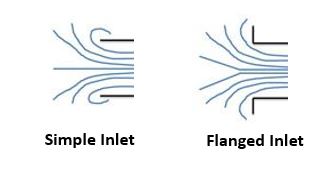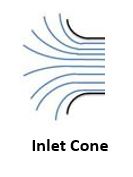Industrial fans are selected on the basis of delivering a required volume of air against the system total static pressure. But what amount of static pressure should be added to the system total static pressure for the fan itself? In this week’s blog, I’ll discuss the three types of pressure losses, frictional, dynamic and component, that are caused by the fan and which of these should be included in the systems total static pressure.
Frictional Pressure Loss
Frictional pressure losses are the result of air particles coming in contact with stationary surfaces. In long duct runs, this can be significant. However, because the fan housings are very short for most industrial fan types, the frictional pressure losses are minimal. Additionally, frictional pressure losses are already accounted for in the fan curve and therefore do not need to be added to the system total static pressure.
Dynamic Pressure Loss
 This type of pressure loss is caused when an air stream makes turns, diverges, converges, narrows, widens, enters or exits. For an industrial fan, there is a moderate amount of dynamic pressure loss from the air entering and exiting the fan. The diagrams to the right show the air entering fans with simple and flanged openings.
This type of pressure loss is caused when an air stream makes turns, diverges, converges, narrows, widens, enters or exits. For an industrial fan, there is a moderate amount of dynamic pressure loss from the air entering and exiting the fan. The diagrams to the right show the air entering fans with simple and flanged openings.
The pressure losses from these two types of fan openings occur because some of the air entering the fan must make a 180 degree turn for the simple opening and a 90 degree turn for the flanged opening. The amount of dynamic static pressure loss is determined by the loss coefficient for either opening type and the velocity of the air at the fan opening.
The good news is that the fan curves for most manufacturers will already incorporate the dynamic pressure losses of the fan inlet and outlet into the performance of the fan. That means the fan inlet and pressure losses do not need to be added to the system total static pressure.
 One way to reduce the system total static pressure is to add an inlet cone to the fan opening. The diagram to the left shows that adding an inlet cone creates a more gradual directional change of the air entering the fan and reduces the loss coefficient which means a lower dynamic pressure loss. If an inlet cone manufacture does not provide data to calculate the static pressure decease, it can be estimated using the difference in the loss coefficients between the inlet cone shapes and the opening type assumed by the fan curve. Loss coefficients for most duct geometries can be found in the ASHRAE Handbook or in the Handbook of Hydraulic Resistance.
One way to reduce the system total static pressure is to add an inlet cone to the fan opening. The diagram to the left shows that adding an inlet cone creates a more gradual directional change of the air entering the fan and reduces the loss coefficient which means a lower dynamic pressure loss. If an inlet cone manufacture does not provide data to calculate the static pressure decease, it can be estimated using the difference in the loss coefficients between the inlet cone shapes and the opening type assumed by the fan curve. Loss coefficients for most duct geometries can be found in the ASHRAE Handbook or in the Handbook of Hydraulic Resistance.
A good reason to use an inlet cone is when the total system pressure requires increasing the fan horsepower. The cost of adding an inlet cone maybe cheaper than the additional capital and operating costs of the higher horsepower motor.
Component Pressure Loss
Component pressure loss results from adding physical items to a fan such as filters, dampers, hoods, and guards. Pressure losses due to adding these components must be added to the system total static pressure. Most component manufacturers will provide data so that the pressure loss associated with a component can be determined based on the air velocity at the inlet or outlet of each component.
Conclusion
Adding a fan to a ventilation system does not change the system total static pressure because the frictional and dynamic pressure losses have already been factored into the fan curve by the fan manufacturer. Only pressure losses from fan components need to be added to the system total static pressure.
